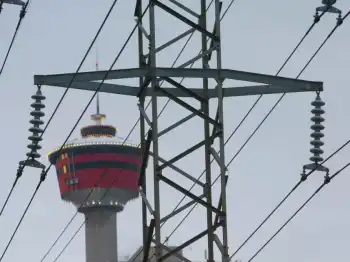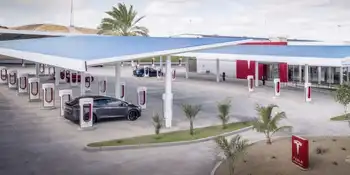When water and water mix
By Reuters
Protective Relay Training - Basic
Our customized live online or in‑person group training can be delivered to your staff at your location.

- Live Online
- 12 hours Instructor-led
- Group Training Available
Two tiny projects to mix sea and river water – one by Oslofjord south of the Norwegian capital, the other at a Dutch seaside lake – are due on stream this year and may point to a new source of clean energy in estuaries from the Mississippi to the Yangtze.
The experiments, which seek to capture the energy released when fresh and salt water are mixed, build on knowledge that has been around for centuries – in one case imitating the process of osmosis used by trees to suck water from their roots.
Although they are far from being economically feasible, if eventually successful they might help a long-term quest to diversify away from fossil fuels such as coal and oil, widely blamed for stoking global warming.
"We might well be able to find new promising solutions such as generating power naturally from osmotic forces occurring when salt and fresh water are mixing," Norwegian deputy Energy Minister Liv Monica Stubholt said earlier this month.
And rivers flow round the clock, an advantage compared with variable wind or solar power.
Oil, currently trading not far from a record $112 (US) a barrel, is forecast to peak this year as a U.S. slowdown reduces demand. Analysts polled by Reuters in February saw the average price remaining above $80 in 2010.
The UN Climate Panel said in 2007 that energy sources such as waves, tidal power or salt are a long way off – unlikely to make a significant contribution to overall power needs by 2030.
The science at the heart of the projects is the fact that when salt and fresh water mix at river mouths, they are typically warmed by 0.1 degree Celsius. Dutch scientists say such energy at all the world's estuaries is equivalent to 20 per cent of world electricity demand.
The plants may support hopes that the technology can overcome hurdles, the most significant of which is poor cost-effectiveness of the membranes used in the process.
In Norway, power group Statkraft, which says it is Europe's top producer of hydro and wind energy alongside Électricité de France, is building a test plant costing $20-million.
"Ours will be the world's first saline power plant based on osmosis," said Stein Erik Skilhagen of the state-owned company.
The plant, at Tofte on Oslofjord, will have output of up to about 5 kilowatts – enough to run household appliances such as washing machines or heaters or a few dozen light bulbs.
The Dutch Centre for Sustainable Water Technology (Wetsus) will also in three to four months start a pilot "blue power" test at IJsselmeer in the Netherlands, from where water flows into the sea.
"At the start, it will be on the scale of 100 watts...but we aim at this salt factory to obtain 1-5 kilowatts within one year," said Jan Post, a researcher at Wetsus.
The Norwegian and Dutch plants use different systems, but both depend on membranes placed between the salt and fresh water, and which are currently prohibitively expensive and highly energy-intensive to produce.
"The Achilles' heel for this process is that there is no commercial membrane," said Menachem Elimelech, a professor of chemical and environmental engineering at Yale University in the United States. "It's not even close to being economical."
The membranes are similar to, but thinner, than those used at many desalination plants, when sea water is pressed against membranes that allow only fresh water through in a process known as reverse osmosis.
Makers of membranes such as General Electric, Dow Chemical, Hydranautics or Japan's Toray Industries focus most on membrane technology for desalination – a market growing by about 15 per cent a year worldwide.
Ellen Mellody of GE Infrastructure, Water and Process Technology said the company has "an aspirational goal" of producing fresh water from salt through membranes at a cost of 10 cents per cubic metre, down from 70 cents to a dollar.
Asked about prospects for a separate market for power-generating membranes, she saw one "potentially, but not for about five, 10 years".
The Norwegian project will include 2,000 square metres of plastic membranes, through which fresh water will be sucked into salt water by osmosis.
The power of osmosis was shown in 1748 when French physicist Jean-Antoine Nollet put a pig's bladder filled with alcohol in a trough of water. The bladder swelled and burst as the more concentrated alcohol drew pure water into it.
At Tofte, the power exerted by salt water sucking in fresh water is equivalent to water falling 270 metres in a waterfall. The only emissions are brackish water.
Unlike the osmosis of the Norwegian system, the Dutch scheme captures salt particles that give off electrical currents.
Yale's Mr. Elimelech said a full scale plant would demand membranes covering perhaps 40 hectares, and which would be at risk of damage by pollutants dissolved in the river or the sea.
Also, filters would have to be in place to avoid sucking in fish and there are environmental concerns about drawing water away from estuaries, perhaps threatening plants and creatures in the area.
"The membrane is the challenge," Mr. Skilhagen said. "In tests, we have come over three watts per square metre (of membrane), but we have to reach five. When we do that it will be industrially interesting."
The Dutch project is close to producing two watts per square metre of membrane. "In theory, both techniques use the same energy source and you could in theory get the same amount of energy out," said Sybrand Metz, project leader at Wetsus.
The Dutch government, utility Eneco and Redstack research group are also making a feasibility study of a plant on the Afsluitdijk dam between the IJsselmeer and the Wadden Sea, with a 10-50 kilowatt installation to be built that could lead to a 200 megawatt capacity if it works.
"Membrane-based technologies are voracious energy consumers," said France's Veolia, which runs huge desalination plants. It wants to cut energy consumption of membrane desalination by 80 per cent over 15 years.











